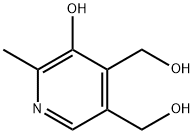65-23-6

Product Name:
Pyridoxine
Formula:
C8H11NO3
Synonyms:
Pyridoxine, Vitamin B6;Pyridoxol;Pyridoxol (pyridoxine);Vitamin B6
Inquiry
CHEMICAL AND PHYSICAL PROPERTIES
| Physical Description | White powder; [Alfa Aesar MSDS] |
|---|---|
| Melting Point | 159-162 °C |
| Solubility | 220000 mg/L |
| Vapor Pressure | 0.00000028 [mmHg] |
| LogP | -0.77 |
| Ionization Efficiency | Positive |
| Collision Cross Section | 134.6 Ų [M+H]+ [CCS Type: DT, Method: single field calibrated with Agilent tune mix (Agilent)] |
| Chemical Classes | Biological Agents -> Vitamins and Derivatives |
SAFETY INFORMATION
| Signal word | Warning |
|---|---|
| Pictogram(s) |
 Exclamation Mark Irritant GHS07 |
| GHS Hazard Statements |
H315:Skin corrosion/irritation H319:Serious eye damage/eye irritation H335:Specific target organ toxicity, single exposure;Respiratory tract irritation |
| Precautionary Statement Codes |
P261:Avoid breathing dust/fume/gas/mist/vapours/spray. P321:Specific treatment (see … on this label). P302+P352:IF ON SKIN: wash with plenty of soap and water. P305+P351+P338:IF IN EYES: Rinse cautiously with water for several minutes. Remove contact lenses, if present and easy to do. Continuerinsing. P405:Store locked up. P501:Dispose of contents/container to..… |
COMPUTED DESCRIPTORS
| Molecular Weight | 169.18 g/mol |
|---|---|
| XLogP3 | -0.8 |
| Hydrogen Bond Donor Count | 3 |
| Hydrogen Bond Acceptor Count | 4 |
| Rotatable Bond Count | 2 |
| Exact Mass | 169.07389321 g/mol |
| Monoisotopic Mass | 169.07389321 g/mol |
| Topological Polar Surface Area | 73.6 Ų |
| Heavy Atom Count | 12 |
| Formal Charge | 0 |
| Complexity | 142 |
| Isotope Atom Count | 0 |
| Defined Atom Stereocenter Count | 0 |
| Undefined Atom Stereocenter Count | 0 |
| Defined Bond Stereocenter Count | 0 |
| Undefined Bond Stereocenter Count | 0 |
| Covalently-Bonded Unit Count | 1 |
| Compound Is Canonicalized | Yes |
PRODUCT INTRODUCTION
description
Pyridoxine is a hydroxymethylpyridine with hydroxymethyl groups at positions 4 and 5, a hydroxy group at position 3 and a methyl group at position 2. The 4-methanol form of vitamin B6, it is converted intoto pyridoxal phosphate which is a coenzyme for synthesis of amino acids, neurotransmitters, sphingolipids and aminolevulinic acid. It has a role as a cofactor, a human metabolite, a Saccharomyces cerevisiae metabolite, an Escherichia coli metabolite and a mouse metabolite. It is a monohydroxypyridine, a vitamin B6, a member of methylpyridines and a hydroxymethylpyridine.